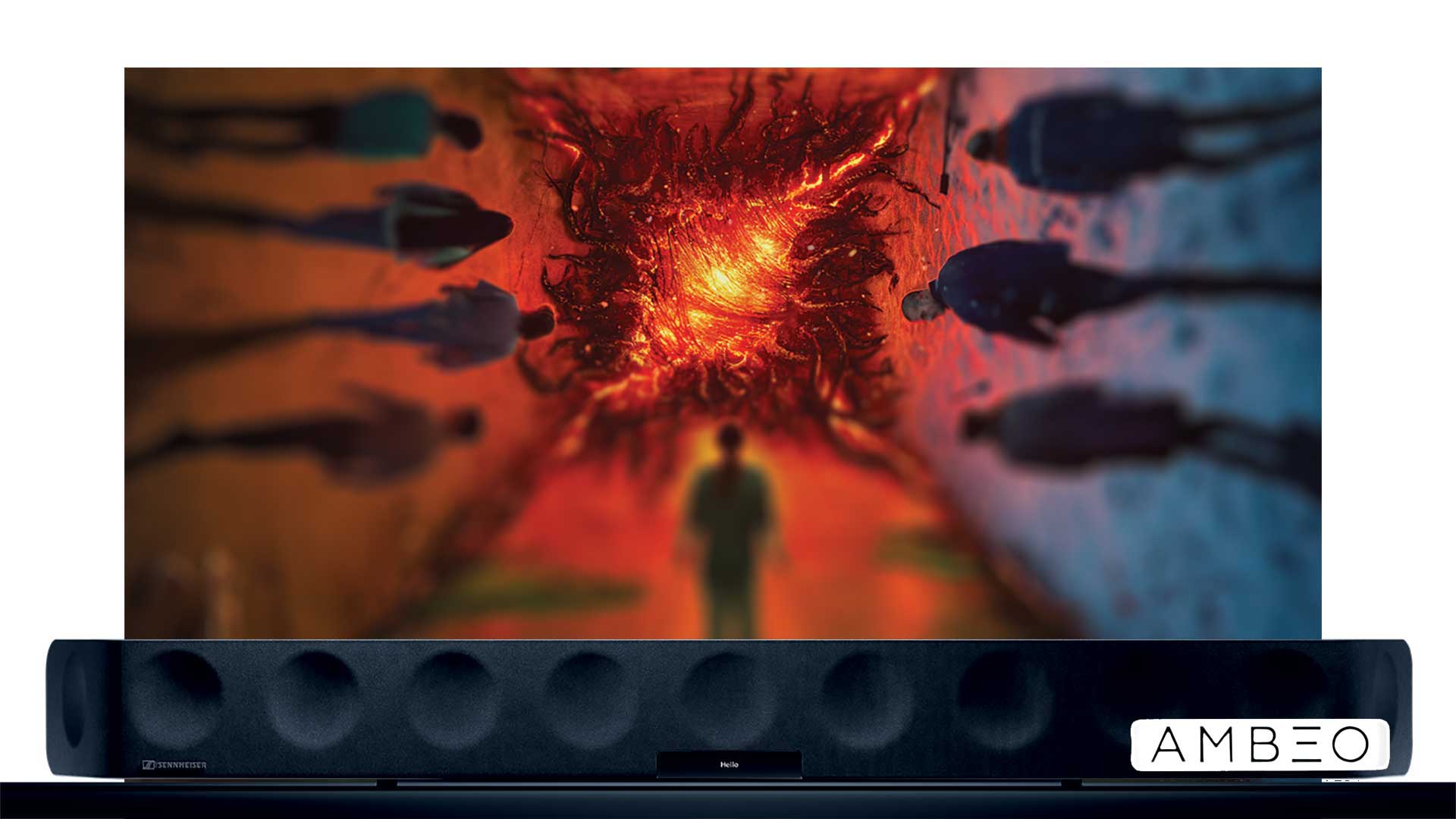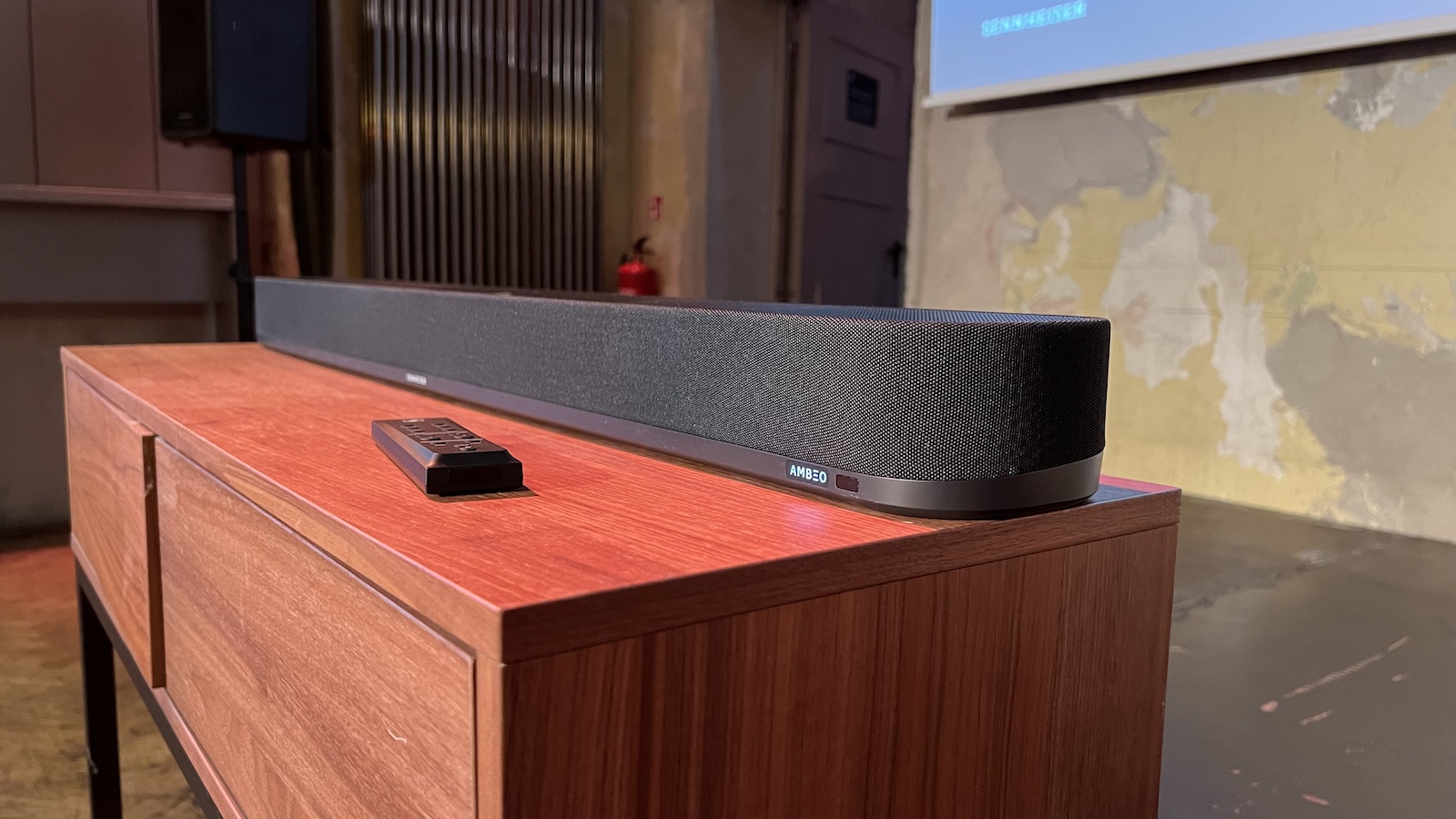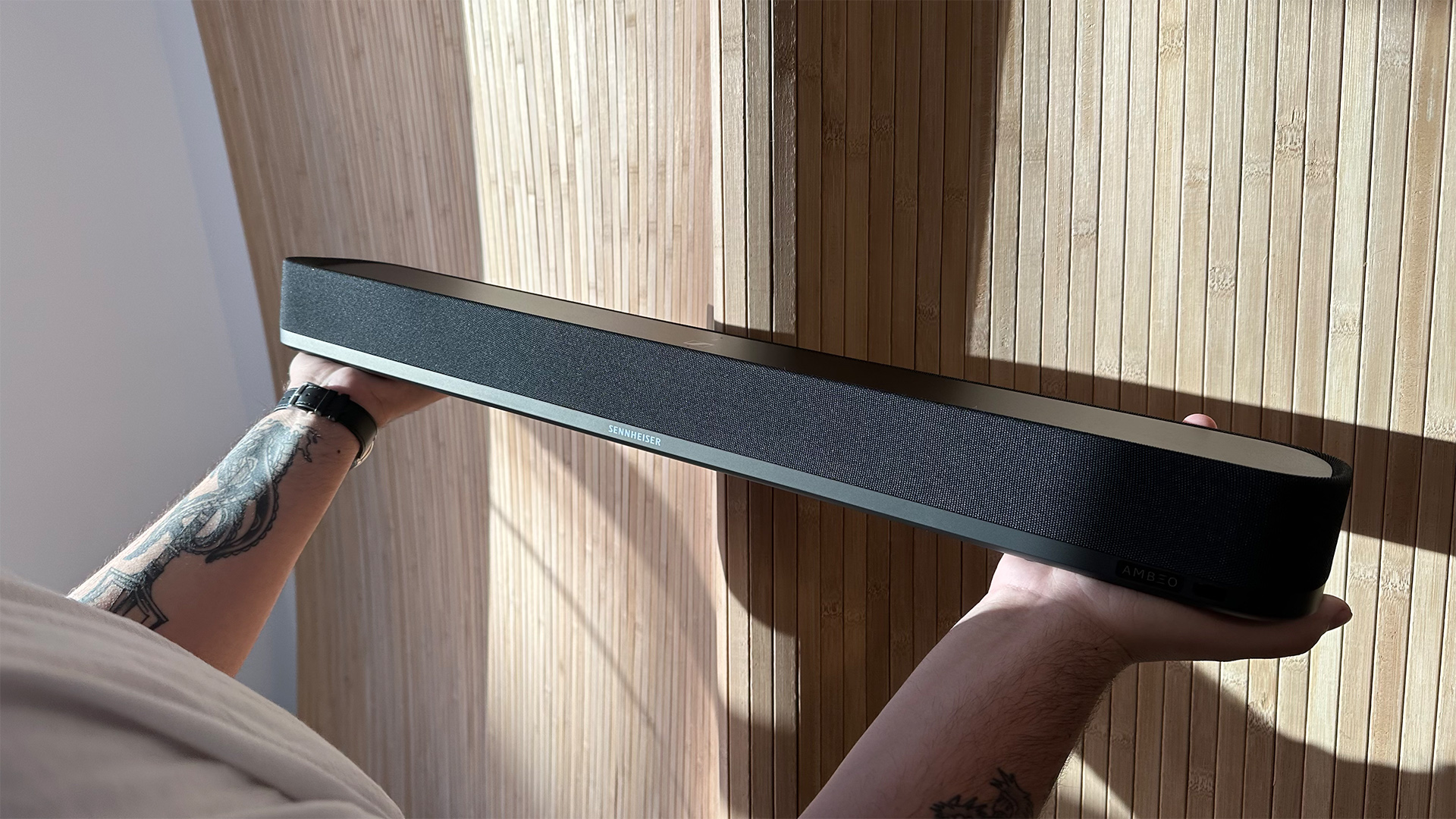Which Sennheiser Ambeo soundbar should you buy?
Which will create the right 'Ambeance' for you?

We know we bang on about it quite a bit, but a soundbar really is one of the simplest – and cheapest – ways to boost your TV's sound quality. With even the best TVs offering pretty poor audio, a decent soundbar is a sound investment (pardon the pun), and won't crowd the room with speakers.
Sennheiser isn't best known for its soundbars. In fact, until recently, it didn't even dabble in the category. Then in 2020, it went all in with the Ambeo (since renamed the Ambeo Soundbar Max), a behemoth of a soundbar with enough power to fell an OLED. It was big. It was expensive. It was fussy over placement. We loved it, bestowing upon it a What Hi-Fi? Award every year since launch – that's three on the trot. That doesn't happen very often.
Perhaps unsurprisingly, Sennheiser has sought to capitalise on this success with two more Ambeo models – the Ambeo Soundbar Plus and Ambeo Soundbar Mini. That makes one big happy Ambeo family.
But not all Ambeos are created equal. Here we will run down what the differences are between them and how they fare so you can see which – if any – is right for you.
Should you buy the Sennheiser Ambeo Soundbar Max?

The Ambeo Max is an easy product to recommend, but only in the right circumstances.
Why easy? Because it sounds superb. With 13 front, side and upward-facing drivers, it delivers a generous 5.1.4 channels of Dolby Atmos sound. This makes it one of the most authoritative-sounding soundbars around. The dynamics really are exceptional for a one-box device, as are the scale and spaciousness.
Most soundbars have relatively small drivers, but these are dwarfed by the Ambeo Max's. Because these larger drivers can cover more of the frequency range, there's no need for a separate subwoofer (though you can partner it with the Ambeo Sub, if you so wish).
Its design does have some quirks. The ports are on the unit's underside, so every time you want to access them you will need to roll over the device, which takes quite a bit of space, not to mention muscle. But it's pretty generous with its array of ports (three HDMI 2.0 and one HDMI 2.1 eARC), so you shouldn't have to access them too often. That eARC port can handle Dolby Atmos in its lossless True HD format, while the other HDMIs can pass through signals from external sources in 4K HDR, including Dolby Vision. There's also a subwoofer pre-out, should you think the Ambeo Max isn't quite powerful enough already and want to connect an external sub. Your poor neighbours.
All major wireless technologies are supported too, giving you plenty of streaming options.
Its size can be its biggest drawback though. For starters, you will need space to accommodate it, either with a large TV cabinet or room to wall-mount it. Whichever method you choose, you will need to proceed with caution. In a cabinet, it's so big it can obscure part of the screen on some TVs. Don't think about placing it on a lower shelf or you will obstruct the upwards-firing drivers that create Dolby Atmos's height effects. And if you're wall-mounting it, make sure your wall is up to withstanding 18.5kg of soundbar permanently hanging off it. You also have to buy the wall-mounting bracket separately.
Lastly, there's the price. For £2199 / $2500 / AU$4000, you could buy a decent surround system such as the Wharfedale Diamond 12.1 HCP and have enough left over for an AV receiver. But that, of course, would require even more space.
Should you buy the Sennheiser Ambeo Soundbar Max?
If you can afford it, and have space to accommodate it, yes, definitely. It's authoritative, feature-packed and sonically, it blows the competition out of the water.
Is it the best soundbar at its price?
We think so. Not for nothing have we given it three What Hi-Fi? Awards in a row. The nearest competition is the Sonos Arc (£899 / $899 / AU$1499), which is very good but lacks the Ambeo Max's bass levels, and the Sony HT-A7000 (£1199 / $1300 / AU$1699), which doesn't quite have the same authority as the Ambeo Max.
- Read our full Sennheiser Ambeo Soundbar Max review
- Dolby Atmos: What is it? How can you get it? What speakers do you need?
- Check out the best Dolby Atmos soundbars
Should you buy the Sennheiser Ambeo Soundbar Plus?

All this wasn't lost on Sennheiser. Aware that, while the Ambeo Max is a superb soundbar, it's certainly not for everyone, it launched a sibling model in 2022, the smaller, more conventional Ambeo Soundbar Plus. But with the Max's outrageous size being key to its appeal, can the Plus still stand out?
Not to the same degree, certainly, but it's still a very talented, five-star soundbar.
For starters, it's a lot cheaper. At £1299 / $1500 / AU$2400, it's £900 / $1000 / AU$1600 cheaper than the Max. The Max has been discounted in the past, but at time of writing it's back up at its original price.
While it's nowhere near as gargantuan as the Max, the Plus is very solid with a quality finish. And at 6.3kg, it's about a third of the weight of the Max – your back will thank you. It's also shorter and narrow than most rival soundbars in its class, making it an ideal choice for smaller spaces.
Specification-wise, it's very similar to the Max, but with less power; it has nine speakers to the Max's 13, and dual 10cm subwoofers. Two of these drivers and both subs face upwards to bounce sound off the ceiling for immersive audio, so don't place it on a lower shelf of your TV cabinet as you will obscure these up-firers. Two of the drivers point diagonally outwards on the corners of the soundbar to create a wider spread of sound.
You get only two HDMI 2.0 ports to the Max's three, but the eARC port is still present and correct. As well as Dolby Atmos in the higher-quality True HD format, it supports DTS:X, MPEG-H and Sony 360 Reality Audio. It boasts the same streaming options as its big brother, and the same app for tweaking playback.
Despite its smaller size, it can still fill a room with aplomb. The 'Ambeo' setting certainly widens the soundstage, but it does sacrifice precision in the process. That's especially true of dialogue. You can toggle it on or off depending on the scene (on for when you demand scale, off for the talkie bits), but no one in their right mind will want to do that. It's a shame Sennheiser couldn't create a best of both worlds setting, but hopefully a software update will fix this.
The Dolby Atmos handling is spectacular. The upwards-firing speakers create a truly authentic sense of height, while music sounds detailed and natural, with a solid sense of dynamics.
Should you buy the Sennheiser Ambeo Soundbar Plus?
The Ambeo Plus is a great choice for anyone looking for Ambeo levels of scale without the space – or desire – to accommodate the Ambeo Max. It brings with it the spaciousness and presentation of the bigger device (albeit scaled back slightly), along with most of the same features.
Is it the best soundbar at its price?
Not quite. It's just edged out by the Sony HT-A7000, a soundbar so good that it has won Product of the Year two years in a row at the What Hi-Fi? Awards. But the Ambeo Plus is a good alternative to the Sony, especially if you have less space. On a smaller budget? The Sonos Arc is definitely worth considering, though we would stretch to the Sony or Ambeo Plus if you can.
- Check out the Sennheiser Ambeo Plus review
- And the Sony HT-A7000
- Those with less to spend should consider the Sonos Arc instead
- 22 of the best Dolby Atmos movie scenes that put your soundbar to the test
- 5 mistakes everyone makes with Sonos' Dolby Atmos soundbars
Should you buy the Sennheiser Ambeo Soundbar Mini?

And so we come to the newest member of the Ambeo family. Like Master Gee in The Sugarhill Gang, the Ambeo Soundbar Mini is the baby of the bunch, and given the pedigree of its siblings it has a lot to live up to.
Sadly, it's the black sheep of the family.
At £699 / $800 / AU$1300, it is up against some stiff competition, most notably the Sonos Arc and Beam Gen 2. It's more stylish than those models, but the design is marred by awkward port placement. You also lose the HDMI passthrough of its larger siblings (though this is common for soundbars in this section of the market).
Again, you get support for Dolby Atmos (via the higher-quality Dolby True HD format courtesy of the HDMI eARC connector), as well as DTS:X, MPEG-H and Sony 360 Reality Audio immersive audio codecs. But the Mini has no upwards-firing speakers, and so employs digital processing to recreate the height channels. You also get the same Sennheiser app, wireless technologies, and room calibration and Ambeo sound features of other Ambeo models.
So far, so good. But it's in the sound department that things really fall apart. Six drivers is three fewer than the Ambeo Plus gets, and seven fewer than the Ambeo Max – and it shows. While the sound is clear with plenty of detail, the soundstage is woefully narrow. Projection is also poor, especially for a Dolby Atmos soundbar, as it struggles with pushing sound out into the room.
The lack of spatial separation is jarring, as sound effects all compete for your attention in a clamorous mess. And the dynamics are nearly non-existent, lacking any kind of punch or dynamism.
It's not all bad. The Ambeo mode does improve the scale, and the 'bar can go loud without distortion. There is decent clarity through the midrange too. But at this money? Forget it.
Should you buy the Sennheiser Ambeo Soundbar Mini?
No.
Is it the best soundbar at its price?
Not by a long shot. While the Sonos Arc is more closely priced, it's the Beam Gen 2 that really puts things in perspective. Despite being a whopping £250 / $350 / AU$650 cheaper than the Ambeo Mini, the Beam outperforms it comfortably. Richer, warmer and more engaging overall, the Beam is also noticeably more Atmos-y, with greater attention given to the spatiality of the sound and more evident overhead effects.
- Read our full Sennheiser Ambeo Soundbar Mini review
- And our review of the Sonos Beam Gen 2
- Also consider: Sonos Arc
- And the Sony HT-A5000
- Best soundbars: Top options for every budget
How about Sennheiser Ambeo alternatives?
Of course Sennheiser's Ambeo soundbars aren't the only game in town. Lots of other companies make quality soundbars at a range of sizes and prices, including Sony, Sonos, Yamaha and Roku.
Lots of these offer the same Dolby Atmos feature as Sennheiser's Ambeo models, though their effectiveness varies – compatibility with Atmos is no sign of quality. So make sure you read one of our reviews before buying.
Some models (such as Sonos's) can also slot seamlessly into a surround sound or multi-room setup.
You will need to consider the dimensions of a soundbar, and whether it will fit your current setup. If you are placing it in front of your TV, make sure it's not so tall that it will obscure part of the screen.
To see which other models are available, check out our guides below.
- Best budget soundbars for spending less cash
- Best Dolby Atmos soundbars for more immersive sound
- How to choose the right soundbar for you
- Sonos Beam Gen 2 vs Sonos Beam: which is better?
- Sonos Arc vs Sonos Beam (Gen 2): which Dolby Atmos soundbar is best?
Get the What Hi-Fi? Newsletter
The latest hi-fi, home cinema and tech news, reviews, buying advice and deals, direct to your inbox.
Joe has been writing about tech for 20 years, first on staff at T3 magazine, then in a freelance capacity for Stuff, The Sunday Times Travel Magazine (now defunct), Men's Health, GQ, The Mirror, Trusted Reviews, TechRadar and many more. His specialities include all things mobile, headphones and speakers that he can't justifying spending money on.

